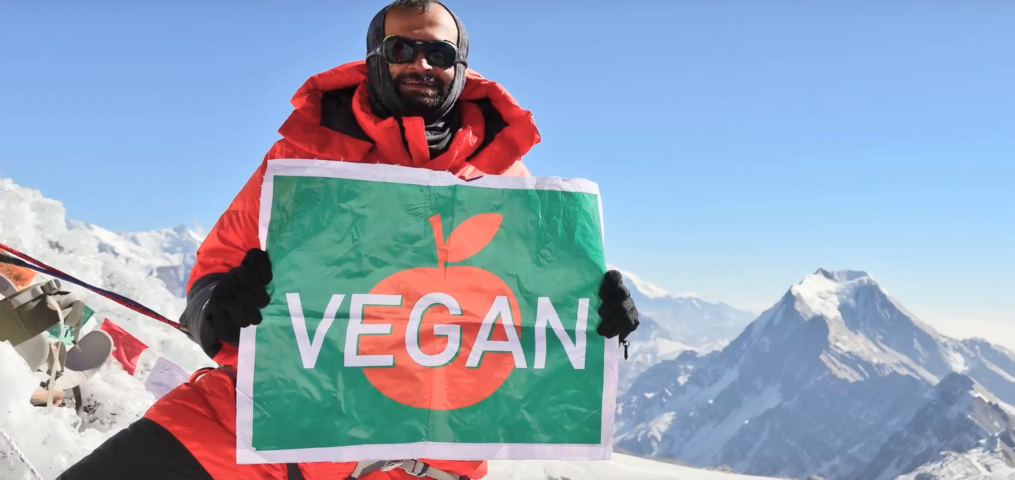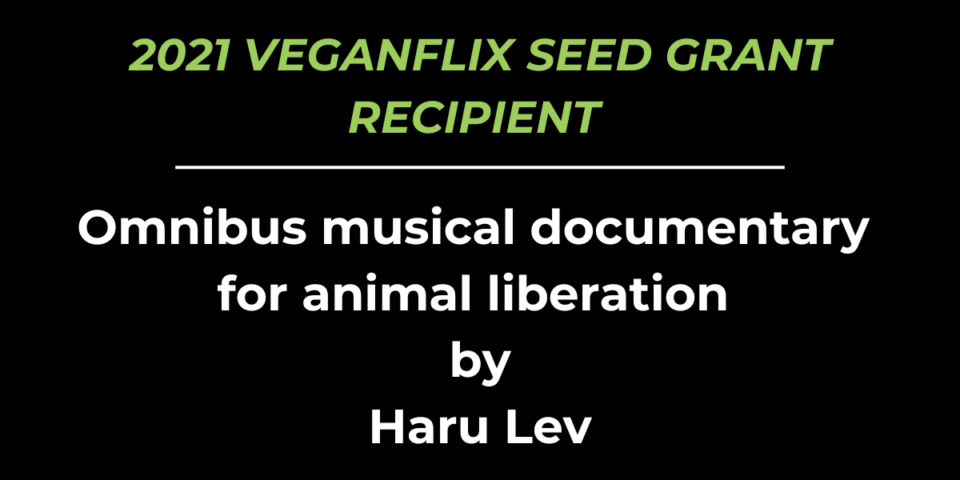Infinity and Back: VeganFlix Interview with Kuntal Joisher

Infinity and Back: VeganFlix interview with Kuntal Joisher
We are thrilled to get the chance to speak with Software programmer Kuntal Joisher who is the first vegan ever to have climbed Mount Everest from the south side. His film Infinity and Back tells the story of Kuntal’s unrelenting love for the mountains, his dreams and struggles, and finally his triumphant journey to the top of Mt. Everest.The movie is a collaboration between Cosmic Maps and Radical Brahmas.
Hello Kuntal Joisher!
VF-You mentioned that being vegan actually gives you an advantage when climbing mountains. Why do you think that is?
KJ-For the initial portion of my Vegan journey I didn’t care about nutrition or eating clean. I went Vegan for ethical reasons and as long as I was eating Vegan, I didn’t care if I was a junk food Vegan. Before going Vegan I was around 107 kgs. After I went Vegan over few years I got down to 78 kgs even though I was eating the same amount of food (sometimes more) and I was majorly eating vegan junk food. So just by going from Vegetarian to Vegan I lost 30 kilos in spite of not eating healthy.
However when I decided to climb Everest, and started to train for Everest I quickly realized that my diet was not supporting my training. For example, on one of the days I would train hard, however I would not recover quickly. There could be several things causing that. My workout was incorrect, my form was bad, my food and fuel were wrong etc. I took care of the first two things and still I had hard time recovering. So thats when I spoke to my friend Lindsay Nixon at Happy Herbivore and she helped me quite a bit with understanding nutrition vis-a-vis my training. Basically the mantra was to go on a low-fat high carb diet, and I was very much onboard. The diet has done wonders for me on the mountain, and even when I’m not on the mountain! My recovery after excruciating climb days or workout days is far superior to what I’ve experienced before.
I think I know less than 1% about nutrition field, so there’s tons and tons of stuff to learn, and I’m constantly learning on a daily basis from my own experiments and experiences and from reading a variety of blogs of nutritionists, scientists etc. To me it’s very important what I put in my stomach. The cleaner I eat, the cleaner I fuel, the healthier and happier my body is going to be.
But more than the physical aspect, it’s the mental aspect that’s given me a strong edge. I can climb with utmost peace and focus knowing that no animal was killed or harmed for me to stand on top of some of the highest mountains of the world!
All this said, I never compare or proclaim that my diet is superior to some other diet. All I care about is proving to the world that big mountain climbing is very possible on a healthy vegan diet!
VF-Was it a struggle to eat vegan while climbing Everest? What did a typical day’s worth of food look like for you?
KJ-Most people in the mountaineering world might think I’m crazy, seeing as the recommended diet for extreme climbing expeditions includes salami, spam, cheese, processed meats, candy bars, hard-boiled eggs, and milk powder. I can’t eat any of these high-fat high-protein animal products. I’ve been a vegan for about 15 years now and I’d consider myself a vegan for life. This is a way of life for me, no matter what endeavors I attempt. I was born and raised as a vegetarian, but I became a vegan to take a stand for animal rights while studying in the US at the University of Southern California. I don’t think my personal stance on the subject will waver any time soon, despite the extreme physical challenges I put myself through. But, my diet has never been an issue.I’ve been part of over more than 35 serious trekking and climbing expeditions, and I’ve never had any problems being a vegan.
Coming to what my typical food intake looks like — it’s mostly oatmeal, wide variety of vegetables (boiled, stir fry, curries), breads, rice, potatoes (boiled, sautéed, French fries), pasta, noodles, dumplings, chickpeas, kidney beans, lentils, soups, fresh and canned fruits etc. It’s primarily a carbohydrates dominated meal along with decent amount of protein and fats. In addition, there’s a whole bunch of comfort food such as dried fruits, nuts, chocolates, nutrition bars, deep-fried chips, oreo biscuits, peanut butter etc that we snack on.
However, once we were at Camp three (24,000 feet) and beyond, I survived on mainly few things: Unived RRUNN gels,Outdoor Herbivore freeze dried meals, Oreo cookies, Dried Kiwi fruit pieces, Deep fried snacks, cashew nuts, and some Green tea flavored water.
VF-During the video you mentioned that you need an enormous amount of patience to succeed in climbing mountains, since many of the days you aren’t actually climbing. How did you keep yourself occupied during this “down time?” Was there any specific books you read or anything else that inspired and motivated you?
KJ-One of the big reasons why a lot of mountaineers fail to climb Everest is because they aren’t able to deal with the down time on the mountain. Their minds starts playing all sorts of games and they finally make excuses and go home. I had personally experienced a similar setback on a different mountain. I got homesick during the downtime and made up an excuse that the “mountain” is not safe and turned around and came home. Rest of my team made it to the top, and till date the regrets are all mine. I learned my lesson and told myself that if I want to get to the top of Mt. Everest and back down safely in one piece then it was hyper-critical to stay razor sharp focused.
During the downtime, I typically spend a lot of time seeing movies, reading books, spending time with my team-mates discussing everything from Hollywood to politics to religion etc, discussing strategy with the Sherpa team, meeting mountaineers from other teams at the base camp so on and so forth. I also spend a lot of time hiking around the base camp to stay fit, and pursuing my other passion – photography. I also spend a lot of time “sleeping”. I easily sleep about 13-14 hours daily during the down-time. This helps my body and mind recover.
However, let me tell you, after doing all these things you still have a lot of time that you have to spend with yourself. And this is where the razor sharp focus comes in handy. I’m completely single focused on how to get to the top and back down safely, and no other thoughts ever enter my mind.And if there is ever a time I’m down and out, I think of my father – who is suffering from Lewy Body Dementia (LBD), and the suffering of billions of animals that are cruelly butchered every minute, and tell myself that I’m doing it for them!
VF-At the end of the video, you said “I conquered my personal Everest.” Was there any point during the climb when you contemplated giving up and turning around?
KJ-Short answer. No. There was never a point during my 8 year journey that I thought of giving up and turning around.
My first attempt to climb Everest was in Spring 2014. Originally our expedition was set to begin on April 1st and, on April 18th, we were scheduled to go through our first climbing rotation through the treacherous Khumbu ice-fall. This was the same day as the avalanche tragedy (in which 16 Sherpa guides were killed). Due to complications, our plan was delayed, and we began the expedition on April 3rd instead. Despite the late start, our team made good time, putting us on track to still make our first visit to the icefall on April 18th. However, my bags consisting of all our technical gear never made it to the base camp, which meant our schedule was delayed again. Call it fate or destiny or luck, or whatever, we never went through the icefall on the 18th and I stayed alive to tell the story.
Ultimately, despite support from my family and team, I made the decision to postpone my long-awaited climb until next year. It wasn’t an easy decision to make. I had trained for years for that moment, only to have my dream literally come tumbling down the mountain. However, 16 Sherpa guides were lost to the mountain, and I was devastated by the loss. At the same time, I was grateful beyond words for my safety. The mountain was there long before me, and it would remain for many millions of years to come. I told myself – I can wait one inconsequential year to see it again.
My second attempt to climb Everest was in Spring 2015. On April 25th we had completed our first acclimatization climb to Camp two on Mt. Everest. Our team had come down and we had all gathered in the dining tent. We were discussing our climb from past few days. And then suddenly the ground started shaking. I could feel it. I tried to tell everyone what I had just felt. Everyone dismissed me. One of my team-mate said you “You seem to have a case of Altitude sickness!” Which can happen actually—when you think you feel stuff but it’s all in your head. And then, the ground started shaking harder. This time everyone took notice. I shouted, “Earthquake!” and we all ran out. The entire ground was swaying like I’d never felt before. It felt as if I was standing on a swing that was swaying hard! Because we were stationed on a glacier, a few people were concerned that the very ground beneath us would open up and swallow us whole, kind of like in a cartoon. It wasn’t likely but it was a huge block of ice and it could break apart. I was scared. Everyone was. In every direction we could see people out of their camps standing and looking nervously in all directions. By then the earthquake had gone on for a while now. For someone who’s never been in an earthquake it doesn’t happen all at once. The shaking can go on for 30 seconds all the way up to 2 full minutes sometimes. For us, it lasted about 60 seconds then stopped.
For a moment we were relieved, until we heard the loudest noise of our lives – it was like a huge bomb blast. Based on the direction of the sound we all looked east, toward Everest, to see what’s happening. But it only took a few seconds to realize something was wrong. We saw several people running towards the direction Everest. And I thought to myself – How could this be possible? Why would people run towards danger?
And, that’s when I realized that an avalanche had occurred right behind us. A huge block of snow and ice the size of a cricket stadium had broken off the top of Mount Pumori, a few hundred meters to the west of base camp. The block fell off the mountain at an unreal speed and as it impacted with the ground it turned into a huge aerosol cloud filled with snow, ice and debris and headed towards the base camp at category 5 hurricane speed. 250 kms per hour. We turned around to find ourselves face to face with this huge white cloud of snow and ice. Huge doesn’t even come close to this. It was like something out of a nightmare. It was the largest thing I had ever seen in my life—taking up all of the sky as far as I could see from the left to the right.
The only thought that came to my mind in that moment was that I was going to die. It wasn’t that I might die but I knew I would die. I remember feeling a strange kind of emptiness, a sadness that I had never felt before.
I wanted to cry out loud. I didn’t want to die. There were so many things I still wanted to do. But, there was nowhere to run, nowhere to hide. I was going to die. Several years ago when I stood on top of a Himalayan peak my life changed. And now my life was going to change again.
I was with two other team-mates as the avalanche cloud hit us. We jumped behind a tent when the cloud hit. Within seconds we were all covered from top to bottom in inches of snow, cutting off the already thin oxygen. I couldn’t breathe. I felt as if someone had put a plastic bag around my face. It took super human effort to suck any air into my lungs. It’s because when the huge block of ice broke and landed, it set into motion a cloud of gas that was not air, but aerosol. There’s no oxygen in it. I surely would have suffocated had it not been for my good friend, Jost, who saw my struggle and opened his hard-shelled jacket for me to put my head inside and breathe. Those first molecules of air entered my lungs, making me feel like a newborn baby taking his first breaths. I had received a second life. I knew it then, and I will know it for rest of my life, that I will forever be indebted to Jost for saving my life.
We had no idea when the cloud would stop and what would happen next? A couple of minutes later the cloud passed over, and there was a eerie calm in the air. More than anything I was relieved that I was alive. We did a head count of our entire team. Everyone was doing Ok, but a significant part of the base camp was devastated with equipment torn apart, debris laying everywhere, it was like a war-zone. Later we heard that more than 20 people had died and over 60 were injured. We rushed to the medical camp with some supplies and water. Just as we entered the medical camp we saw several injured climbers being brought in. And then I saw a Japanese couple that was being attended to. To my shock I realized that the lady was missing half of her face. It was only flesh and bones. Which is when we started realizing the gravity of situation.
In addition to snow and ice, things such as huge stones, mountaineering supplies, tent poles, pressure cookers, and other things had also been thrown in every which direction. And then we heard about this one guy. He was sleeping in his tent when the avalanche hit and the force of the cloud was so tremendous that the entire tent flew in the air nearly half a kilometer over huge rocks after finally coming to a halt inside the ice field. When the rescuers got to the tent they found this person’s body completed smashed to pieces. It was one of the most gruesome ways to die. That’s when we realized that we were plain lucky that we were about 100 meters away from the center of the avalanche’s main impact. The difference between a gruesome death and staying alive was just those one hundred meters.
Anyway, we knew what had happened to us was tragic, but once we heard from friends in Kathmandu, notifying us about the devastation that had occurred across Nepal, we were heartbroken to learn that more than nine and half thousand people had died, tens of thousands were injured, and over half a million displaced from their homes. It began to sink in that this wasn’t a mountain-climbing tragedy; this was a disaster of unprecedented levels. As the leader of the team I sat down with the Sherpa sirdar and we decided to call off the climb. It absolutely didn’t make sense to go up the mountain. It was just too risky. After shocks and avalanches were continuing and I had no intention to put any more lives in danger. I also wanted my entire staff to go home and be with their families in the time of need. And above all any more accidents on the mountain would divert all the focus away from the immense tragedy that had occurred in Nepal. It was time to go back to Kathmandu and see if we could help in any possible way.
After I got back to Kathmandu I visited the village of Sankhu some 30 kms away from the capital on a relief mission. As we came upon this once lively and boisterous village, all I could see for miles was a city turned into rubble. So many precious lives lost to the wrath of nature. I was shattered. A country that I had come to call my second home had been devastated. The drive back to the hotel was one of the most difficult of my life. I spent the next three days in Kathmandu, feeling the panic of phantom earthquakes, even though there were none. This effect continued even when I got back to my home in Mumbai for the next couple of weeks. Every single night the only thing I dreamt about was the disaster in Nepal. Every day I would wake up thinking about how the Nepali people must be coping if this was my reaction having been there for only 10 days. There have been more than 300 aftershocks in Nepal since. I can’t imagine how it must feel to try and sleep at night.
Post my first two attempts in 2014, and 2015, several people dissuaded me from climbing saying — ‘the mountain doesn’t want you there’, and some even said – ‘I don’t have it what it takes’. I didn’t listen to them. Instead I kept the fire inside me burning, trained harder than ever, never gave up on my dream, and finally made it to the top in May 2016 on my 3rd attempt!
The lesson I learnt is that one should never give up on their dream. People will say things such as – you are crazy, it’s impossible, you are sure to fail etc. And a lot of those things will happen. But if you want to achieve your dream you have to nurture and protect it like your baby, work and train hard and smart, learn from your failures, and keep going at it until you reach to the top! As the saying goes, there are No shortcuts to the top!
VF-Now that you have accomplished the biggest dream of your life, what are some of your future goals and aspirations?
KJ-Earlier this year, I was leading a team of novice climbers on a 20,000 feet mountain in the Himalaya. During the descent, I picked up an injury – a tear in the medial meniscus of my right knee. For last 4 months I have been focusing on recovering from the injury. Few weeks ago, I climbed to the top of Mt. Shasta in Northern California and my knee held up pretty well. My hope is to continue recovering for next couple of months and then I head back to the Himalaya to climb a 20,000 feet mountain. Post the climb I’ll have a better idea of the condition of my knee and at that point I’ll decide the future course of action. My hope is to continue training for the coming 5 months before heading back to Nepal in Spring 2018 to climb my next big mountain. However, that’s all too much into future. My immediate next goal is to recover and be 100% fit!
Outside of my climbing aspirations, my next passion is to spread the message of Veganism. Since my Everest climb, I have done more than 100 talks and reached out to over 16,000 people in person and shared my journey to climb Everest as a Vegan. In addition to this, I blog extensively about my Everest journey as a Vegan and share my learnings from the journey with my social media followers. My hope is that even if a fraction of the people who I reach out to bring a change in their lives especially in terms of their food choices then it’s a huge win for the animals, for the planet, and above all for everyone.
The whole idea behind making the movie “Infinity and Back” was to show the audience what it takes to climb Everest, but at the same time share the message of “Never give up”, and “Anything is possible on a Vegan diet including climbing to the Top of the World!”.
I hope to continue climbing and I hope to continue debunking myths around Veganism.




